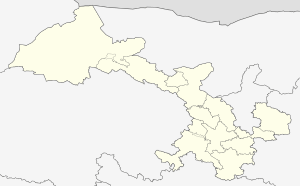Minqin County
| Minqin County 民勤县 | |
|---|---|
| County | |
 Minqin Location of the seat in Gansu | |
| Coordinates: 38°37′26″N 103°05′38″E / 38.624°N 103.094°ECoordinates: 38°37′26″N 103°05′38″E / 38.624°N 103.094°E | |
| Country | People's Republic of China |
| Province | Gansu |
| Prefecture-level city | Wuwei |
| Time zone | UTC+8 (China Standard) |
Minqin County (Chinese: 民勤县; pinyin: Mínqín Xiàn) is a county of Gansu province, the People's Republic of China. It is under the jurisdiction of Wuwei City. Its postal code is 733300, and its population in 1999 was 281,826 people.
In older literature, today's Minqin is referred to as Zhenfan (Chinese: 镇番; Wade–Giles: Chen-fan).[1] According to Pyotr Kozlov, the Mongol name for the city was Sogo Khoto.[2]
Geographically, Minqin county occupies one of Gansu's panhandles, bordering in the north, east, and southeast on the Alashan League of Inner Mongolia.
History
Historically, Chinese agricultural settlement in the area was made possible by the Shiyang River, flowing from the Qilian Mountains.[3] However, the livelihood of Chinese farmers here was often precarious; in the 1920s it was considered as somewhat of a regular famine district.[1] Large number of Zhenfan people, nicknamed "Sand-hollow Mice", worked as "camel-pullers" with caravans owned by Mongols from the adjacent Alashan, or moved—temporarily or permanently—to Xinjiang. For example, as of 1926, the main population of the small oasis of Santanghu (now, officially, Santanghu (三塘湖乡) in what's today Barkol Kazakh Autonomous County of Xinjiang were migrants from Minqin (Zhenfan) and their descendants.[4]
By the late 20th century, the environmental situation in the Minqin area deteriorated, as smaller amounts of the Shiyang River water reached the area, due to the increased irrigation of use of it upstream. Ground water levels fell, and desertification became a serious threat.[3] Minqin is now identified as one of the major sources of sandstorms in China.[3][5]
Geography
| Climate data for Minqin County (1971−2000) | |||||||||||||
|---|---|---|---|---|---|---|---|---|---|---|---|---|---|
| Month | Jan | Feb | Mar | Apr | May | Jun | Jul | Aug | Sep | Oct | Nov | Dec | Year |
| Average high °C (°F) | −0.5 (31.1) |
3.3 (37.9) |
10.2 (50.4) |
18.6 (65.5) |
24.3 (75.7) |
28.5 (83.3) |
30.6 (87.1) |
29.1 (84.4) |
23.7 (74.7) |
16.4 (61.5) |
7.8 (46) |
1.2 (34.2) |
16.1 (61) |
| Average low °C (°F) | −15.1 (4.8) |
−11.5 (11.3) |
−4.6 (23.7) |
2.8 (37) |
8.8 (47.8) |
13.3 (55.9) |
15.9 (60.6) |
14.9 (58.8) |
9.3 (48.7) |
1.4 (34.5) |
−6.1 (21) |
−12.6 (9.3) |
1.4 (34.5) |
| Average precipitation mm (inches) | 0.5 (0.02) |
1.0 (0.039) |
2.8 (0.11) |
4.7 (0.185) |
10.0 (0.394) |
15.9 (0.626) |
23.8 (0.937) |
28.1 (1.106) |
17.2 (0.677) |
6.9 (0.272) |
1.6 (0.063) |
0.5 (0.02) |
113.0 (4.449) |
| Average precipitation days (≥ 0.1 mm) | 1.0 | 1.2 | 1.6 | 2.2 | 3.6 | 5.8 | 7.0 | 6.6 | 5.2 | 2.7 | 0.9 | 0.9 | 38.7 |
| Average relative humidity (%) | 46 | 40 | 38 | 32 | 36 | 43 | 49 | 52 | 52 | 49 | 48 | 49 | 45 |
| Mean monthly sunshine hours | 232.1 | 215.5 | 246.1 | 262.0 | 291.1 | 287.7 | 288.5 | 280.8 | 254.3 | 249.1 | 236.7 | 229.5 | 3,073.4 |
| Percent possible sunshine | 77 | 72 | 67 | 66 | 66 | 65 | 64 | 67 | 68 | 72 | 78 | 78 | 69 |
| Source: China Meteorological Administration | |||||||||||||
See also
References
- http://www.people.fas.harvard.edu/~chgis/work/downloads/faqs/1999_pop_faq.html
- Official website (Chinese)
- 1 2 Owen Lattimore, The Desert Road to Turkestan. London, Methuen, 1928.
- ↑ P.K.Kozlov, "Монголия и Кам. Трехлетнее путешествие по Монголии и Тибету (1899—1901 гг.) (Mongolia and Kham. Three years' travel in Mongolia and Tibet (1899–1901). (in Russian)
- 1 2 3 Will the Desert Claim Minqin?
- ↑ Lattimore (1928), p. 274
- ↑ "Archived copy" (PDF). Archived from the original (PDF) on 2011-08-15. Retrieved 2011-05-28.